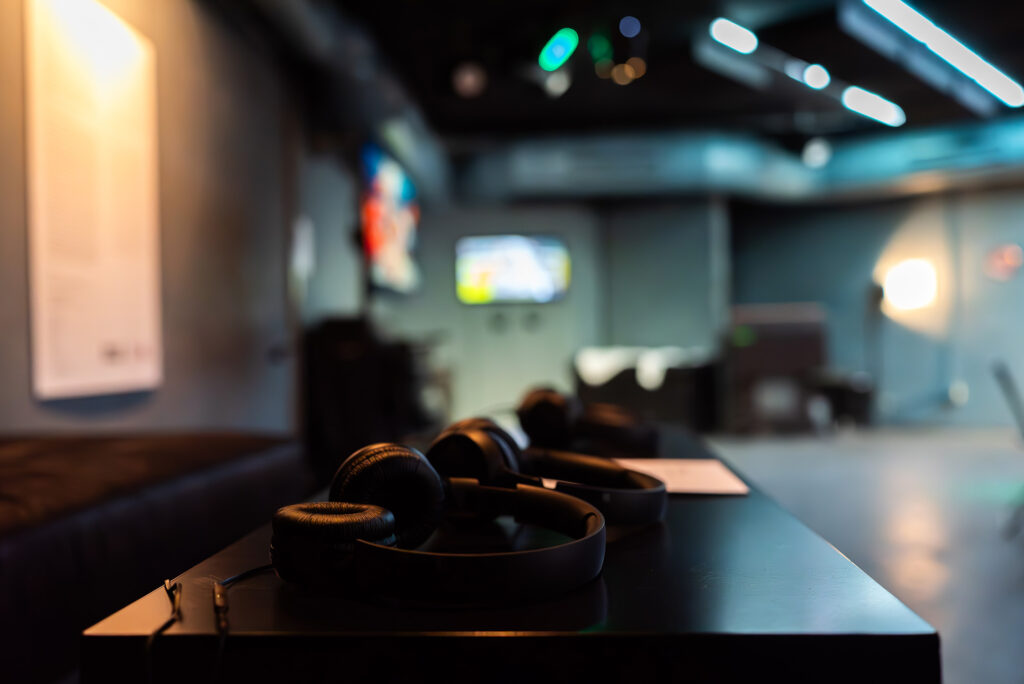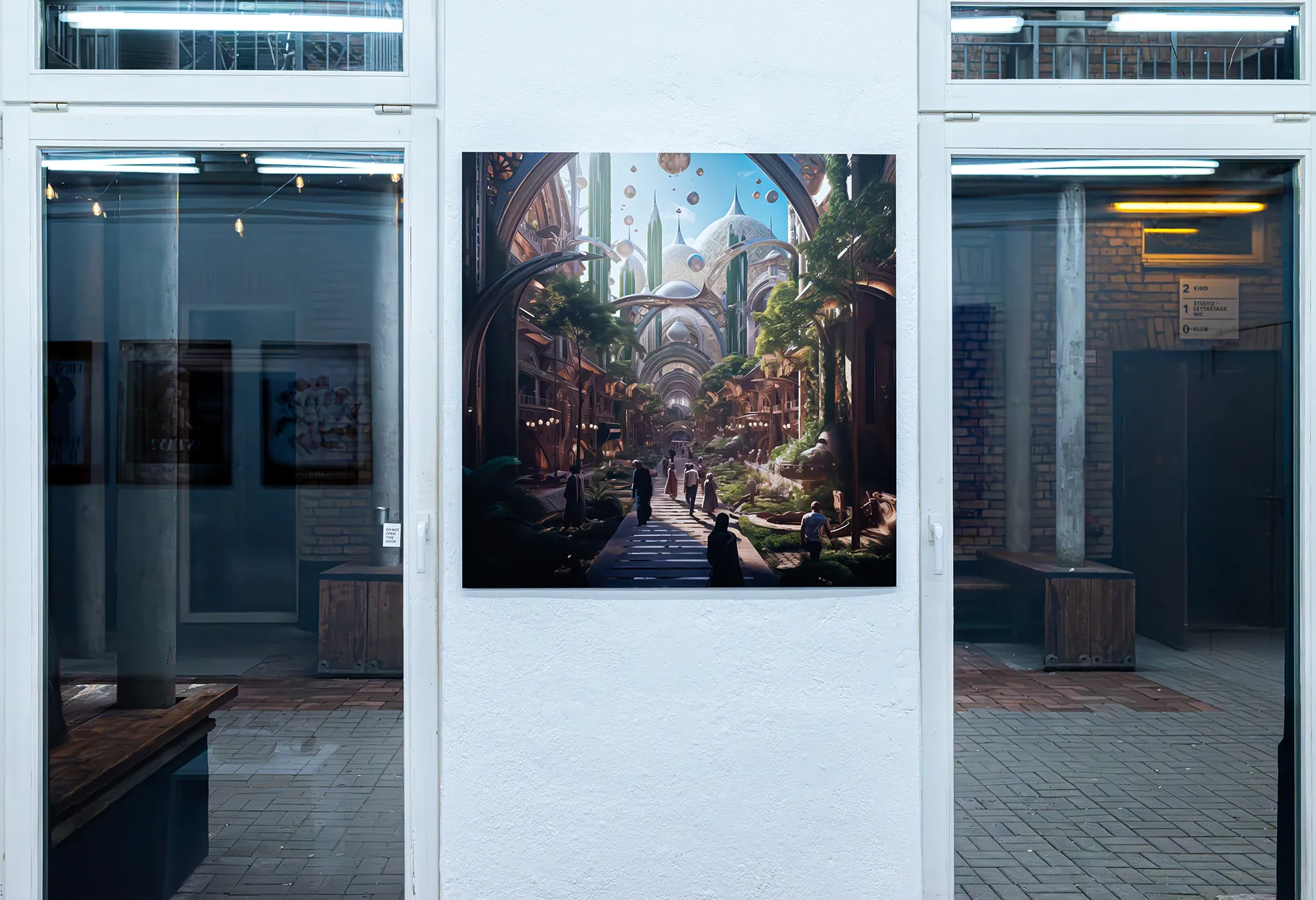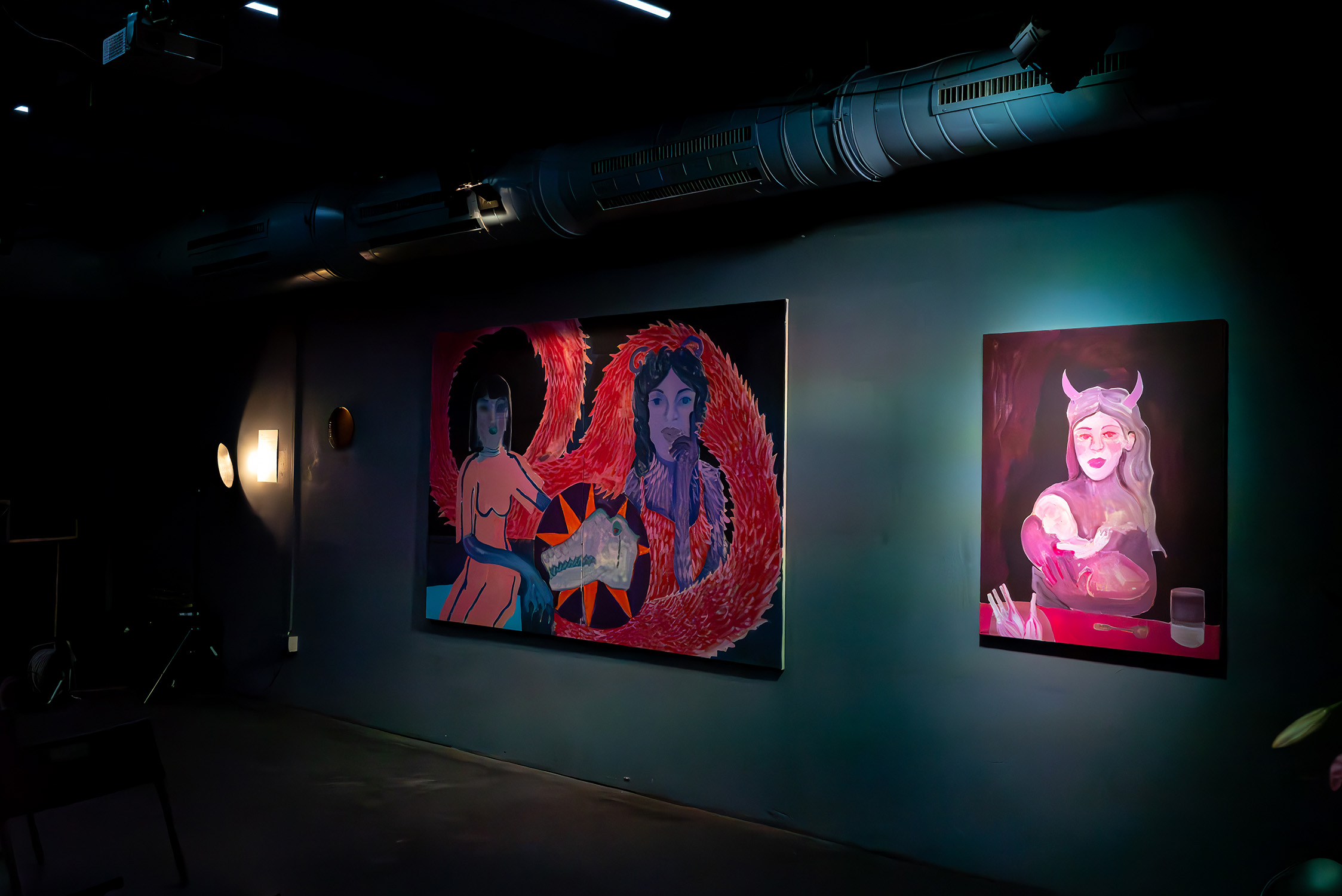Video by Ranja Assalhi
ARCHIVE
Muslim Futures Now
Muslim Futures is a matter. A process. An idea born in the past and translated into today. A piece of future vision in the present, in this moment. So what will happen tomorrow, in ten years, in 100 years, if you dare to imagine today what seems unimaginable? Let yourself fall into lightness and break with ideas of times, dimensions, spaces and the seemingly possible. For what is impossible for the One who makes everything possible? Who creates and says "Be! And it is!" How beautiful we are when we dream, far away from interpretations and standards from the outside? When we listen within ourselves, what do we long for? What do these worlds look like? Do we exist there, is it green, does it taste of freedom? Do we speak? Do we recognize ourselves and each other? What do you long for in these imaginations? Muslim Futures is an expression of longing: the attempt to draw futures that exist simultaneously and also in contradiction. They are visions that we can stand up for today - they dissolve boundaries that exist far removed from norms and hegemonies. And why not?
Muslim Futures is an invitation, too.
Please come in, you are very welcome. You are welcome to leave your shoes on, unless you are entering the dream worlds, then make yourself comfortable.
You are at home. May I pour you a cup of tea with mint?
Fatih is already here: he shows us what it sounds like when we are together. I let myself go, with ease, Hanaa promises me, you could also paint your story if you like. It smells of lilies and upheavals, of dreams plucked in the city of Madinah, we are mindful of each other here, aren't we, Nilgün? The process is volatile, seductive, multi-layered – just like mythological figures that we are so similar to, sometimes at least, right Elif?
Yes, that is you in the mirror, ruling justly and benevolently. Khaled drew you. Do you like yourself like that? How is it that your eyes shine when they are reflected in the fabrics of Anja's khayamiya? We meet in the here and now, but we are interwoven in the seams of our past and future.
Are we about to meet Abul Abbas in the U8? He dances with me while we write love letters to oblivion, I learned that from Ozan Zakariya. It happens because I imagined it that way. I trust you, I draw strength from us.
God, you are beautiful when you imagine what a better tomorrow feels like. I can feel it in my stomach, can you? My heart leaps, trying to feel your wishes – I long for it, just as Kader visualizes it.
How sweet this world tastes. When I am, believe, love and fit together, like puzzle pieces at the Cape of Good Hope, Hafssa? I draw from the connections – between here and there, me and you, the (in)visible.
Below you will find the nine works that were displayed as part of our exhibition in January 2024 at ACUD macht Neu. We wish you pure enjoyment, inspiration and pleasure in exploring our Muslim Futures archive.
KADER BAĞLİ
*1996, DE, lives in Stuttgart
A message to your heart, 2024
AI Video Installation
In the midst of a hectic and crisis-ridden world, how can we preserve the purity of our hearts? The AI-generated video installation by the lead VFX artist invites us on a journey that explores, reflects and manifests the essence of the “Kalb-i-Selim” (the pure heart) in images. It focuses on self-reflection, encourages retreat and a decelerated way of life. The focus is on spiritual practices to strengthen the connection to the transcendental, the Creator. The longing for empathy, the interplay of heart and mind and the connections to faith are what define the human being. The pursuit of a Kalb-i Selim designs futures characterised by peace, compassion and mutual support on the path to a pure heart – a foundation for the well-being of all.
ANJA SALEH
*1992, DE, lives in Berlin
Of The Forgotten, The Hopeful, The Dreamer, 2024
Textile Installation
Anja Saleh’s textile installation “Of The Forgotten, The Hopeful, The Dreamer” stands as an examination of the concepts of hope, dreams and the dualism of memory and forgetting. The installation, composed of three pieces, including historic Egyptian Khayamiya art, traditional textiles and cultural motifs, engages with the significance of each element to reflect on their contemporary collective impact on us and our futures.
The blanket, with its tradition as a common household item and symbol of comfort, warmth, and continuity across generations invites us to view „intergenerational dreams“ as an alternative, an addition to the often-discussed theme of „intergenerational trauma“, highlighting the relevance of dreams and dreaming as a starting point for reimagined, just futures.
“Khair inshaAllah“ a typically used phrase or supplication for well-being and a deference to the future’s uncertainty representing a sentiment of trust and hope amidst the unknown.
In the Khayamiya piece, memory and forgetting — each inscribed on the wrists of Hathor and Nefertari holding hands as a symbol for union — Saleh draws attention to the essential dynamic of remembering and forgetting in the construction of future narratives. It is through this interplay that societies value heritage, learn from the past, and are able to imagine futures.
FATIH MARAŞLİOĞLU
*1992, DE, lives in Nuremberg
Dhikr reimagined | Sounds of the Future, 2023
Audio
“To Allah belong the east and the west, so wherever you turn you are facing towards Allah.” – 2:115
If we go back in time and listen to the halaqas of dhikr (remembrance of God), we will hear sounds and instruments like the nay and the oud that are more familiar to some ears – accompanied by poems and texts by Rumi and Hafez. Now, if we could move forward in time, to a world where the East and the West cannot be separated, to a world with hundreds of languages and ways to communicate, thousands of instruments and sounds, and millions of ways to connect. And if we had the opportunity to listen to the halaqas of this time, what would we hear?
HAFSSA EL-BOUHAMOUCHI
*1992, DE, lives in Cairo
Living Divine Empowerment, 2024
short documentary
What defines a religious community? Is it the traditional sources, the cultural identity, or the individuals who fill both with life?
The symbiosis of all these parts brings a community to light. Living Divine Empowerment focuses on individual women from South Africa and tells their stories. The Muslims of the Cape are a special community with a rich history and a diverse Islamic tradition. Their faith has survived the horrors of colonialism and apartheid. Women commemorate this heritage in the present, with a constant responsibility to the legacy and teachings of the Prophet Muhammad (sas). Their faith in the divine message of a better world inspires and empowers them. Living Divine Empowerment reconstructs the past and shapes the future that Muslim women in the Cape (in good hope) have created. The colonial legacy and resistance to apartheid have shaped their community. Their activism gives them vision. What is their message for us and our future?
HANAA ABDELLA
*2000, DE, lives in Nürtingen
strength in softness, 2024
Installation and pastel on paper
Who has the privilege of dreaming of a future and whose dreams have any chance of becoming reality? Many dreams of marginalized people are nipped in the bud before they can be filled with life. With her work strength in softness, Hanaa Abdella is striving to understand dreaming as an act of resilience. Visitors, especially BIPoC people, are invited to spend time in the walk-in installation, to slow down and dream. In artistic dialogues with friends, Abdella explores future thinking and dreaming from a genuinely Muslim perspective. The artistic works resulting from these conversations can be viewed outside the installation.
NİLGÜN AKINCI
*1988, DE, lives in Berlin
AMANAH ─ أمانة,
2024
180° Video in VR
„And do good as Allah has been good to you, and don’t seek to cause the corruption in the Earth. Allah doesn’t love the corrupters.”
Surah Al Qasas: 77
Utopias need to be told – and filled with life by people. Based on the motif of sustainability, Akıncı designs Muslim utopias for the future, which she derives from her studies of Qur’anic content (see visualisation MADINAH). Her knowledge is that the Qur’an repeatedly points to an optimistic and merciful present and future for people – if they choose them. It creates a Muslim future that answers to the social, economic, and ecological dislocations of the present. A future that offers a real alternative for all humankind. Based on the Causal Layered Analysis (CLA) developed by Sohail Inayatullah in 1998, Akıncı develops starting points for humanist-Muslim futures that become real by being imagined in the first place. This gave rise to the video AMANAH أمانة:
AMANAH أمانة deals with the verses in Qur’an 2:30 in which the angels question the right of humankind to exist on earth, when they will cause mischief and shed blood. But Allah knows what they do not know.
ELIF ÇELIK
*1997, DE, lives in Ulm
Ishtar and Shahmaran with severed crocodile head, 2023
Acrylic, oil pastels on cotton
Is that Medusa, or is it Salome with the severed head of John the Baptist? The centuries-old myth of the dangerous and yet so powerful woman who seduces and kills men is still deeply rooted in the canon of European art and cultural production. Ishtar, the mother of the “femme fatale”, and next to her Shahmaran, the ruler of the serpents of the underworld, join the sexist depiction of Muslim women in Europe in the 18th century as orientalist harem representations. What do these representations mean for the self-image of young Muslim women and how can they be represented appropriately? Elif Çelik pleads for a look into the past before we ponder alternative futures. She translates mythological figures such as Ishtar, the Babylonian goddess of love who is still omnipresent in “WANA areas”, into the here and now. As a young Muslim artist, Çelik breaks with stigmas and creates representation by rejecting the eurocentric perspective on art and transferring the past into the present.
OZAN ZAKARIYA KESKİNKİLİÇ
*1989, DE, lives in Berlin
&
FABIAN SAUL
*1986, DE, lives in Berlin
“Abul Abbas. between the gaps of the maps”, 2024
Lyrical audio piece
On July 20, 802, an elephant passed through the city gate of Aachen alongside the Jewish merchant and interpreter Isaac from Narbonne – a gift from the Abbasid caliph Harun al-Rashid to Charlemagne. The animal covered over 5,000 kilometers, from Baghdad via the Tunisian coast to Italy along Lake Maggiore, over the Alpine passes and into the Frankish Empire. The lyricist Ozan Zakariya Keskinkılıç brings Abul Abbas back to life and describes his story in landscapes and scenarios to break down the boundaries of belonging, desire and history. The compositions by sound artist Fabian Saul traverse space and time like uncertain architectures that follow the ghostly presence of the elephant.
KHALED AL SAADI
*1998, DE, lives in Berlin
TIMESTAMPS, 2024
Video
Faith in God, our desires for the future and tipping points.
Climate change is continuing to create dystopian conditions for the future of life on our planet. We are confronted with new crises every day and at the same time rebel against them.
Taking responsibility, taking a stand and thinking alternatives – in the work TIMESTAMPS, Khaled Al Saadi deals with the inner conflict between the desire for more influence in society and the ever-increasing challenges associated with climate change. How much longer do we have to wait for access to the levers of influence before the tipping points are passed – and the sun rises in the West? Or has it already risen there and we are right in the middle of it?
NEW DAILY, 2024
Collage
Imagining a Muslim chancellor, a female judge with a hijab or a German culture-shaping Muslim director in today’s Germany is either unimaginable or associated with high adjustment dynamics. But what happens when we tear ourselves away from this unimaginability and imagine a future in which we become everyday faces?
With New Daily, Khaled Al Saadi explores the moment when Muslims take up positions within society, becoming new common and ubiquitous figures in public life. A work about feelings that arise, ideas that are currently considered abstract and wishes that come true.








